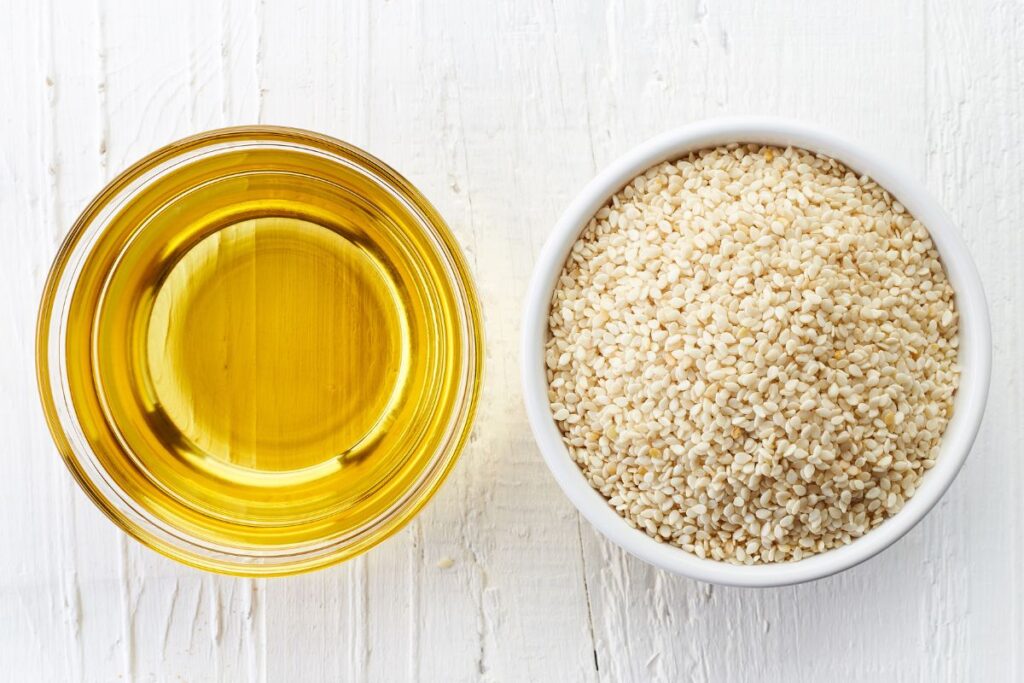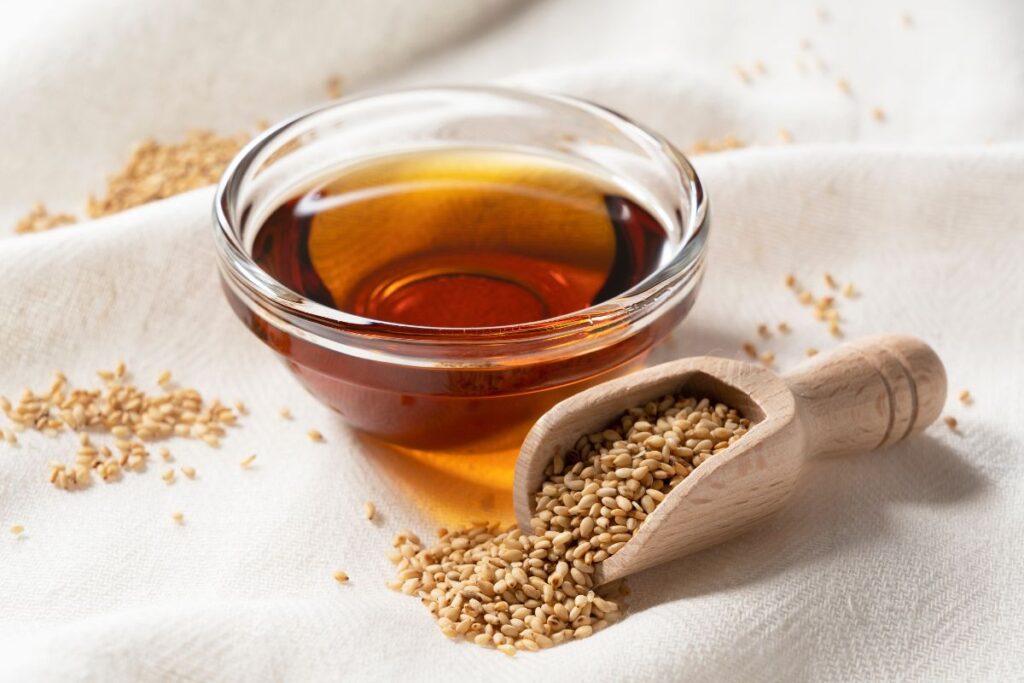Did you know that a single ingredient can make all the difference in the flavor and authenticity of a cuisine? In Japanese cooking, that ingredient is sesame seeds and oil.
These tiny seeds might seem insignificant, but they are anything but. In fact, they play a pivotal role in adding depth and complexity to Japanese dishes, far beyond just topping your favorite sushi roll.
From dressings and sauces to marinades and desserts, sesame seeds and oil bring a rich, nutty accent to both savory and sweet dishes, showcasing their incredible versatility.
Join us as we delve into the world of sesame in Japanese cuisine, exploring its origins, different types, and essential recipes that highlight its unique flavor.
Along the way, we’ll also uncover the nutritional benefits that these small yet mighty seeds bring to the table. Get ready to elevate your cooking repertoire with a touch of tradition and a whisper of nuttiness that you never knew you needed.


The Origins of Sesame Seeds in Japan
Sesame seeds first made their way to Japan from the Korean Peninsula during the Asuka period (538–710 AD), becoming a staple in Japanese cooking.
You’ll find that understanding this journey gives you the ability to appreciate the depth of flavor they add to dishes, empowering you to make informed choices in your culinary adventures.
Grasping the historical significance of sesame in Japan allows you to harness its full potential, elevating your cooking from simple meals to gastronomic experiences steeped in history.
As you dive deeper into the origins of sesame in Japan, you’ll discover that its introduction marked a turning point in the culinary landscape. Sesame seeds weren’t just adopted for their taste; they were revered for their health benefits and versatility.
You have the power to leverage this knowledge, selecting sesame seeds and oil that best suit your dishes, whether you’re aiming for a subtle nutty undertone or a bold flavor statement.
Types and Uses of Sesame Seeds and Oil in Cuisine
In Japanese cuisine, the variety of sesame seeds and oil plays a pivotal role in crafting dishes with distinct flavors and textures.
You’ve got white, black, and golden sesame seeds at your disposal, each offering a unique taste and utility in the kitchen. White sesame seeds, often used lightly toasted, add a subtle crunch and nutty flavor to salads and sushi rolls. They’re your go-to for a delicate touch.
Black sesame seeds, on the other hand, pack a bolder, earthier taste, perfect for garnishing noodles or incorporating into desserts like the traditional black sesame ice cream. Their striking color also adds visual appeal to dishes, making your meals not only tasteful but also beautiful.
Golden sesame seeds, somewhat rarer, find their way into dressings and marinades, offering a slightly different nuance in flavor compared to their white and black counterparts.
As for sesame oil, it’s indispensable. A few drops can transform a simple stir-fry or soup with its rich, nutty aroma. Remember, toasted sesame oil has a stronger flavor than its untasted sibling, so you’ll want to use it sparingly to avoid overpowering your dishes.
In mastering these variations, you’ll elevate your culinary creations with both tradition and innovation, giving you control over the depth and character of your cooking.
Essential Recipes Featuring Sesame
Having explored the diverse types and uses of sesame in Japanese cooking, let’s now focus on some key recipes where these seeds and oil truly shine.
You’ll harness the power of sesame to elevate your cooking, transforming simple ingredients into dishes that resonate with depth and tradition.
First, tackle Goma-ae, a spinach salad lightly dressed in a sesame sauce. You’ll quickly toast white sesame seeds, then grind them into a paste, mixing with soy sauce and sugar for a balance of nuttiness and sweetness.
It’s a testament to how you can control flavor profiles with the simplicity of sesame.
Next, Sesame Ramen introduces a rich, creamy dimension to your noodle bowls. By emulsifying roasted sesame oil with chicken broth, soy sauce, and a dash of mirin, you create a base that’s both comforting and complex.
The addition of toasted sesame seeds as a garnish not only adds texture but also a burst of flavor with each bite.
Lastly, mastering the art of making Goma Dofu, or sesame tofu, showcases the versatility of sesame. This dish blends white sesame paste with water and kudzu starch, resulting in a silky, savory custard that’s steamed to perfection.
It’s a delicate process, but you’re in control, crafting a dish that’s as elegant as it’s flavorful.


Health Benefits and Nutrition of Sesame Seeds and Oil
You’ll be amazed to discover that beyond their role in enhancing flavors, sesame seeds and oil offer remarkable health benefits and nutritional value.
These tiny seeds are powerhouses of nutrients, essential for maintaining a healthy body and mind. They’re packed with healthy fats, proteins, and fiber, which can help you manage your weight effectively.
Including sesame in your diet could also boost your heart health, thanks to its high content of sesamin, a compound known to lower cholesterol levels and prevent high blood pressure.
Moreover, sesame seeds are a rich source of vitamins and minerals, including calcium, magnesium, and zinc, crucial for bone health. You’ll find incorporating sesame into your meals not only elevates the taste but also strengthens your bones.
Additionally, the antioxidants present in sesame oil can protect your skin from damage, promoting a youthful glow.
Tips for Cooking With Sesame
Why not elevate your cooking with the nutty flavor of sesame seeds and oil, essential ingredients in many Japanese dishes? To master their use, you’ll need a few strategic tips.
First, remember that toasting sesame seeds unlocks their flavor. Heat them in a dry pan over medium heat, shaking frequently until they’re golden and fragrant. This simple step can dramatically transform your dishes.
When it comes to sesame oil, a little goes a long way. Its strong flavor can overpower other ingredients, so use it sparingly. Add a few drops to finish off a dish or incorporate it into dressings for a subtle, yet impactful, taste enhancement.
Storage is crucial for maintaining the quality of sesame seeds and oil. Keep sesame seeds in an airtight container in a cool, dark place. For sesame oil, refrigeration extends its shelf life, preventing it from going rancid.
Lastly, balance is key. Sesame pairs well with both sweet and savory flavors, but it’s important to find the right proportion. Experiment by adding it to various dishes, but always taste as you go to ensure it complements the other flavors without dominating them.
Conclusion
So, now you’ve dived into the world of sesame in Japanese cooking, from its rich history to its diverse uses. You’ve explored essential recipes, reaped the health benefits, and picked up tips for cooking with this nutty accent.
But hey, maybe you’re not convinced about the hype around sesame. Maybe you have a different perspective or experience with it. We’d love to hear your thoughts and opinions on this!
Leave a comment below and let’s know if you think sesame really lives up to its reputation or if you have any alternative suggestions for enhancing your culinary creations.
Your feedback is valuable to us! So go ahead and share your thoughts.





Konnichiwa! (Hello!) I'm Pat Tokuyama, a Japanese tofu cookbook author, who travels for music, food, and adventure. If you like Japanese tea, checkout some of the newestorganic japanese tea, matcha bowls and noren and more!
** Curious about the Plant Based Japanese Cooking Club? ** Learn more here!